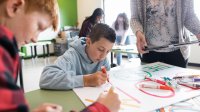Promoting Gratitude in Your Classroom
Expressing gratitude has a lot of benefits for students, and teachers can give them the freedom to express it in different ways to promote student choice.
Your content has been saved!
Go to My Saved Content.Research indicates that gratitude can have an outsized, positive effect on well-being and relationships. We want to optimize this in our learning communities, so let’s look for moments when we can experience and express gratitude.
While research supports writing as a powerful (even calming, for some) way to practice gratitude, it is not the only way. The reality is that we are all unique and dynamic, so a one-size-fits-all approach just doesn’t cut it with gratitude (or anything else for that matter).
The four essential components of the gratitude experience identified by psychologist Andrea Hussong and her team are: notice, think, feel, and do. To realize all the benefits of experiencing gratitude, learners can work through these prompts:
- Notice the things in your life that you can be grateful for.
- Think deeply about why you have been given this thing you value.
- Reflect on how you feel about the gift you have been given.
- What can you do to express appreciation?
The first three prompts are really about reflecting to experience gratitude, and the last prompt is a call to action to express gratitude. We can think of these essential components as our firm goals, and we can offer flexible means to achieve them.
The process of noticing, thinking, feeling, and doing can take as little as a few minutes, or it can be savored over longer periods of time. Before we get to specific examples of firm goals and flexible means related to gratitude, think about your context:
- What are your design opportunities and constraints (e.g., time, space, developmental appropriateness)?
- What resources, supplies, and/or technology could assist in empowering learners?
Ultimately, you want your students to experience and express gratitude to improve well-being and nurture relationships. By affording them the freedom to decide how to do that, you’re meeting the needs of diverse and variable learners and honoring the interests of the individuals who make up your learning community.
Below are some examples of firm goals and flexible means for both experiencing and expressing gratitude.
Firm Goal: Notice the Good
Flexible means: We want to empower learners to notice the good in their lives and in their learning community. We also want to consider ways to offer support for those who want or need it. You could brainstorm topics as a class or offer options like the ones listed below. Either way, learners should understand they have the power to choose.
- Small yet awesome everyday things
- Family, friends, pets
- Health
- Coincidences
- Nature, places
- Experiences
- Life lessons
Firm Goal: Capture What You Think and How You Feel
Flexible means: At this point, we want to make sure we are capturing the experience, and even when we are short on time, we can give the option to draw, write on paper, use a word processor, record a voice memo, or take a photo.
Here are some options you can provide:
- Artistic expression: drawing, painting, sculpture, or collage
- Digital media: videos or slideshows
- Mind or concept maps (e.g., create a circular diagram as a gratitude wheel)
- Performance: storytelling, speech, poetry
- Written reflections: journaling, letter writing
- Other: students can suggest another option
We want to offer a buffet of options, but we don’t want to serve up choice fatigue with a side of frustration. Be sure to consider the needs and interests of the individuals you‘re working with. What means are they already familiar with? What are some options you could model to help them build up their toolkit so they have the skills to take advantage of the choices?
Firm Goal: Do Something to Express Your Gratitude
Flexible means: A learner might choose to continue with “capture what you think and how you feel” from above by gifting their drawing, video, etc. Or they may have something completely different in mind (e.g., social media posts, emails, texts, etc). Either way, we can encourage learners to go the extra mile when they express their gratitude.
In the book The Gratitude Project, Jeremy Adam Smith reveals that the richest thank-yous acknowledge the intentions and the costs while also describing the value of the benefits received. Here are some examples:
Intentions: “Thank you for sending me a copy of your notes when I missed a class.”
Costs: “I‘m grateful that you offered to help me with my project, even though it meant sacrificing some of your free time.”
Value: “I appreciate you explaining that math concept clearly—I finally get it!”
Learning is significantly more efficient when we are in a state of positive emotion rather than a state of negative emotion, and offering learners voice and choice is a great way to honor and value everyone’s lived experience. What can you do to bring more gratitude into your learning community with firm goals and flexible means?
